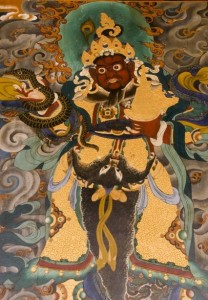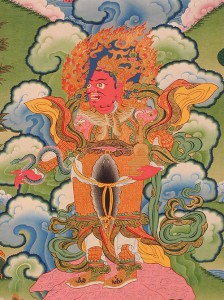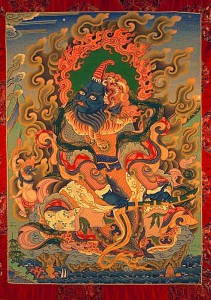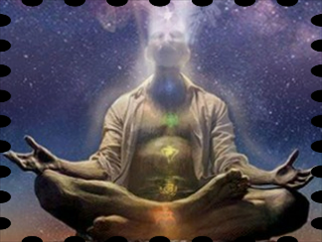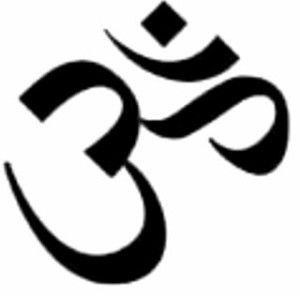FOUR: RIDING THE WAVE
Enraptured in deep samādhis during the revelatory action of the Lord’s discourse within the resplendent spiritual plane of Sambhogakāya, Acintapa the Mahasiddha was abruptly roused from his reverie when the Blessed Vajradhara extracted him, like a tiny insect, from the pore of his luminous skin. Mahasiddha Acintapa’s manomakaya-body then expanded to the same relative-size of the Five Dhyanī Buddha’s Maṇḍala and gradually came to rest above and parallel to this shining ideation of the Tathagatas. His form then began to vibrate at an incredible rate as it slowly descended to merge with the Maṇḍala.
Suddenly the border of the Maṇḍala became a barrier of fire as the Bodhisattva-Yaksha Vajarpanī leapt-up and ignited the protective ring with a blazing flame from his thunderbolt-like vajra. The fiery spectacle subsequently transformed itself into a ring of shimmering vajras—a thousand-fold appearing one after another in quick succession. Gradually, within this diamond-like ring there emerged the forms of eight cemeteries—all orbiting within the ring like bleached planetoids before disintegrating into nothingness.
As the dust dissolved there materialized the Leviathan-size Guardians of the Maṇḍala, each protecting one of the four quadrants:
Dhritarashtra, the Guardian of the Eastern Gate and Regal King of the Gandharvas, struck a chord on his stately Lute and its velvety tone sent waves of ecstasy upon the Mahasiddha Acintapa as his manomakaya body hovered nearby.
Across from Dhritarashtra the resplendent form of the Naga King, Virupaksham, rose and commandeered his position as Guardian of the Maṇḍala’s Western Gate.
Suddenly, a great rumbling sound arose as the stern leader of the ancient Yaksha race, Vaishravana, made his appearance known as Guardian of the Northern Gate.
The appearance of the Guardian of the Southern Gate and King of the Kumbhanda, Virudhaka, effectively sealed the Quadrant of the Fantastic Four who stood faithful watch over the Sacred Maṇḍala. Their formidable presence assured that no actions of the evil one ever invaded this invulnerable sanctuary.
Following the specters of the Four Guardians, the Mahasiddhas manomakaya body began to metamorphose into the primordial elements of the Maṇḍala.
At the Dharmamegha* Chakra (Crown) White Vairocana’s seed syllable, (OṀ) was invoked—OṀ VAIROCANA OṀ
This seed is the Principle of the all-embracing Universal Body (OṀ)
At the Dharmasota* Chakra (Throat) Red Amitabha’s seed syllable, (HRĪḤ) was invoked—OṀ AMITĀBHA HRĪḤ
This seed is the Principle of Inner-Discriminating Wisdom
At the Self* Chakra (Heart) Blue Akṣobhya’s seed syllable (HŪṀ) was next invoked—OṀ AKṢOBHYA HŪṀ
This seed-syllable highlights the role of Akṣobhya as Enlightened Consciousness-Mind of all Buddhas.
At the Sugata-garbha* Chakra (Navel) Yellow Ratnasambhava’s seed syllable (TRAṀ) was invoked—OṀ RATNASAMBHAVA TRAṀ
This seed-syllable highlights the Principle of Equanimity
At the Primordial Dragon* Chakra (Groin [Root]) Green Amoghasiddhi’s seed syllable (ȦḤ) was the last to be invoked—OṀ AMOGHASIDDHI ȦḤ
This seed-syllable represents the Principle of the All-Accomplishing Wisdom.
It was also revealed to Mahasiddhi Acintapa that the subtle energies (winds [prana/Qi]) experienced during the invocation (awakening) of the Chakras were empowered through the heightened sense of Bodhicitta as channeled by the Tathāgatas. Thus the flow of bodhipower is unhindered and undivided.
The Trikayic-Mantra was the next to be invoked:
‘OṀ-AḤ-HŪṀ
This solemn invocation joins the three cardinal principles of Body (OṀ), Speech (AḤ) and Mind (HŪṀ).
In such fashion Mahasiddhi Acintapa’s spirit was united with the Primordial Qi of the Five Dhyanī Buddhas.
The concluding Mantra(s) provided assurance that union was effectively sealed with (1) The Vajra Body (Nirmanakaya) of all Buddhas:
-OM SARVA TATHAGATA KAYA VAJRA SVABHAVA ATMAKO AHAM-
(2)The Vajra Speech (Sambhogakaya) of all Buddhas:
-OM SARVA TATHAGATA VAK VAJRA SVABHAVA ATMAKO AHAM-
(3)The Vajra Mind (Dharmakaya) of all Buddhas:
-OM SARVA TATHAGATA CITIA VAJRA SVABHAVA ATMAKO AHAM-
Having now been blessed by countless Tathagatas in the ten directions, the next stage can be initiated for the generation and union with the Holy Matrix…
*These terms for the Chakras are fully covered in the Lankavatarian Book of the Dead Series: http://unbornmind.com/2012/09/05/the-elixir-of-life-bardo-1-part-5/
Commentary
barrier of fire: Mahasiddha Acintapa is going through a form of purification ritual. The barrier of fire “burns-away” all lingering traces of avidya; even though the Mahasiddha was an advanced Yogin, there still remained residual traces of unwholesome characteristics.
ring of shimmering vajras: these “diamond-like” structures are symbolic of the High Gnosis of Illumination (Bodhi) which is taking place within the heightened consciousness of the Mahasiddha.
there emerged the forms of eight cemeteries: these “eight” are symbolic of the Eight Consciousnesses (seeing, hearing, smell, taste, touch, ideation, disruptive emotions and reflexive awareness). Engaged as he is in a profound Sādhana—a prescribed inner-realization of the Dhyanī Maṇḍala—the former and usual eight aspects of consciousness dissolve-away as the higher-energies of the Tathāgatas become dominant.
The Four Guardians of the Maṇḍala: traditionally these four represent those protective agencies that prohibit any negative forces from penetrating the inner-chambers of the Sacred Maṇḍala. Interesting how, (in reference to the above) Virudhaka, as King of the Kumbhabda, lorded over a class of demons said to dwell in cemeteries. The very root-structure of the word, Maṇḍala, means Protection—hence these four serve to reinforce this characteristic.
The Five Seed (Bīja) Syllables: these sacred sounds and emanations are embedded in any Mandalic Meditation and/or Ritual. As we shall soon discover, of the five, the syllable HŪṀ plays out to be the most significant. It resides in the direct center, or Heart (Self) Chakra, and it becomes the hub for the lower and higher chakras. In this sense it is like a Spiritual Director for the other energies—since it represents Transcendent Consciousness, or the Dhyanī Buddha Akṣobhya. In many of the Tantras of the Vajrayana, he takes center-stage over Vairocana. This is the marvelous thing about Tantric Spirituality and symbolism—there isn’t any one dominant set of parameters that need to be adhered to tooth and nail. In terms of a Maṇḍala, any one of the five Dhyanī Buddhas can take center-stage—depending on the nature of the energies that are set into motion for a particular purpose. In this sense, the Vajrayana is very utilitarian in scope.
The following is a depiction of how the syllable HŪṀ contains aspects of the other four syllables; looking at this one can see why this does represent a “Vajra-Family” affair, since it resembles a Magnificent Diamond Temple—a resilient structure that houses all the divine attributes combined—with Akṣobhya as the head of the household, “mirroring” them all:


